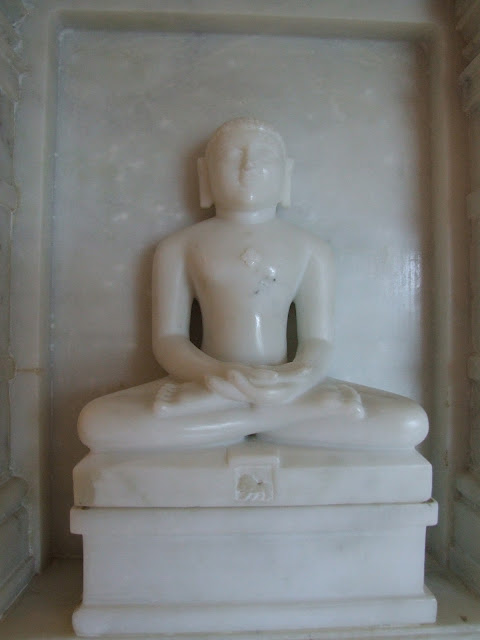Text and pix by Dushiyanthini Kanagasabapathipillai

White Marble structure at the main entrance of the temple in the City of Miltipas
Jainism is an ancient religion that originated in India and belongs to the most ancient of faiths in the world. It teaches the way to liberation and a cornerstone of Jain religious philosophy is the path to bliss being founded on harmless living and renunciation.
The Jains worship 24 ‘Tirthankaras’ or human beings who help in achieving liberation and enlightenment by destroying all of their soul-constraining karmas, as role-model and leaders for those seeking spiritual guidance. They are seen as the ideal of perfection and are identified as: Adinatha, Ajita, Sambhava, Abhinandana, Sumati, Padmaprabha, Suparshva, Chandraprabha, Suvidhi, Shital, Shreyansa, Vasupujya, Vimala, Ananta, Dharma, Shanti, Kunthu, Ara, Malli, Muni Suvrata, Nami, Nemi, Parshva and Mahavir.
The majority of the Jains live in India, and according to the 2001 census, India has a Jain population of about 4.2 million. According to community estimates and Jain leaders, the figure is between six to eight million Jains the world over. About 100,000 live in North America, including 4,000 in the San Francisco Bay Area in Northern California.
The Jain Center of Northern California (JCNC) was founded in 1973 with just 20 families, and now it has a membership of more than 600 families from the Bay Area in San Francisco. The JCNC itself was built in 2000. The architecturally-designed Jain Center of Northern California lies in the Silicon Valley and attracts many Jain worshippers from around the world.

A view of the temple in the City of Miltipas

Jains must be vegetarians

The philosophy and practice of Jainism emphasize the necessity of self-effort to move the soul towards divine consciousness and liberation
Offerings are made in the main shrine hall of the temple

Temple worship is of more importance to lay Jains than to Jain monks and nuns

Jains worship the icons of Jinas,Arihants and Tirthankars who have conquered the inner passions and attained divine consciousness, and study the scriptures of these liberated beings
Lord Mahavir is regarded as the man who gave Jainism its present-day form
Jains believe that the soul exists forever

Lord Mahavir found enlightenment after 13 years of renunciation, and soon made 11 converts at the age o 30

Jainism is a religion of equality

Jainism encourages non-violence,peace and harmony

Shatrunjay Tirth
An image of Lord Mahavir

Ranakpur Tirth

An array of deities

Girnarji Tirth
Usually the worshipper makes eight symbolic offerings to the image of a Tirthankara
Pavapuri Tirth
Every worshipper says "nisihi" while entering the temple. This means "giving up" and indicates that they are moving from the secular activities into spiritual ones
Fasting purifies the body,mind and soul

There are 24 Tirthankaras
Jains believe that to attain enlightenment and ultimately liberation, one must practice the ethical principles such as non-violence, truthfulness,non-stealing,celibacy and non-possession or non-materialism

Leather products are not allowed into the temple

Worshippers in the main sanctum
 Jains believe that the universe has always existed and will always exist
Jains believe that the universe has always existed and will always exist
Pictorial on Ceylon Today of 13th of January 2013
Courtesy: CEYLON TODAY
 The philosophy and practice of Jainism emphasize the necessity of self-effort to move the soul towards divine consciousness and liberation
The philosophy and practice of Jainism emphasize the necessity of self-effort to move the soul towards divine consciousness and liberation
 Jains worship the icons of Jinas,Arihants and Tirthankars who have conquered the inner passions and attained divine consciousness, and study the scriptures of these liberated beings
Jains worship the icons of Jinas,Arihants and Tirthankars who have conquered the inner passions and attained divine consciousness, and study the scriptures of these liberated beings
 Lord Mahavir found enlightenment after 13 years of renunciation, and soon made 11 converts at the age o 30
Lord Mahavir found enlightenment after 13 years of renunciation, and soon made 11 converts at the age o 30


























0 Comments:
Post a Comment
<< Home